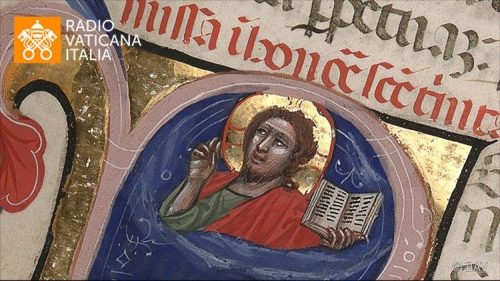LECTURE DU JOUR
1 JN 2:3-11
Beloved:
The way we may be sure that we know Jesus
is to keep his commandments.
Whoever says, “I know him,” but does not keep his commandments
is a liar, and the truth is not in him.
But whoever keeps his word,
the love of God is truly perfected in him.
This is the way we may know that we are in union with him:
whoever claims to abide in him ought to walk just as he walked.
Beloved, I am writing no new commandment to you
but an old commandment that you had from the beginning.
The old commandment is the word that you have heard.
And yet I do write a new commandment to you,
which holds true in him and among you,
for the darkness is passing away,
and the true light is already shining.
Whoever says he is in the light,
yet hates his brother, is still in the darkness.
Whoever loves his brother remains in the light,
and there is nothing in him to cause a fall.
Whoever hates his brother is in darkness;
he walks in darkness
and does not know where he is going
because the darkness has blinded his eyes.
ÉVANGILE DU JOUR
LK 2:22-35
When the days were completed for their purification
according to the law of Moses,
the parents of Jesus took him up to Jerusalem
to present him to the Lord,
just as it is written in the law of the Lord,
Every male that opens the womb shall be consecrated to the Lord,
and to offer the sacrifice of
a pair of turtledoves or two young pigeons,
in accordance with the dictate in the law of the Lord.
Now there was a man in Jerusalem whose name was Simeon.
This man was righteous and devout,
awaiting the consolation of Israel,
and the Holy Spirit was upon him.
It had been revealed to him by the Holy Spirit
that he should not see death
before he had seen the Christ of the Lord.
He came in the Spirit into the temple;
and when the parents brought in the child Jesus
to perform the custom of the law in regard to him,
he took him into his arms and blessed God, saying:
“Lord, now let your servant go in peace;
your word has been fulfilled:
my own eyes have seen the salvation
which you prepared in the sight of every people,
a light to reveal you to the nations
and the glory of your people Israel.”
The child’s father and mother were amazed at what was said about him;
and Simeon blessed them and said to Mary his mother,
“Behold, this child is destined
for the fall and rise of many in Israel,
and to be a sign that will be contradicted
(and you yourself a sword will pierce)
so that the thoughts of many hearts may be revealed.”
LES MOTS DU PAPE
Fully five times the Gospel speaks to us of Mary and Joseph’s obedience to the “law of the Lord” (cf. Lk 2:22-24,27,39). Jesus came not to do his own will, but the will of the Father. This way – he tells us – was his “food” (cf. Jn 4:34). In the same way, all those who follow Jesus must set out on the path of obedience, imitating as it were the Lord’s “condescension” by humbling themselves and making their own the will of the Father, even to self-emptying and abasement (cf. Phil 2:7-8). For a religious, to advance on the path of obedience means to abase oneself in service, that is, to take the same path as Jesus, who “did not deem equality with God a thing to be grasped” (Phil 2:6). By emptying himself he made himself a servant in order to serve.
For us, as consecrated persons, this path takes the form of the rule, marked by the charism of the founder. For all of us, the essential rule remains the Gospel, yet the Holy Spirit, in his infinite creativity, also gives it expression in the various rules of the consecrated life which are born of the sequela Christi, and thus from this journey of abasing oneself by serving.
Through this “law” which is the rule, consecrated persons are able to attain wisdom, not something abstract, but a work and gift of the Holy Spirit. An evident sign of such wisdom is joy. The evangelical happiness of a religious is the fruit of self-abasement in union with Christ… And, when we are sad, we would do well to ask ourselves, “How are we living this kenosis?”
In the account of Jesus’ Presentation in the Temple, wisdom is represented by two elderly persons, Simeon and Anna: persons docile to the Holy Spirit, led by him, inspired by him. The Lord granted them wisdom as the fruit of a long journey along the path of obedience to his law, an obedience which likewise humbles and abases, but which also lifts up and protects hope, making them creative, for they are filled with the Holy Spirit. They even enact a kind of liturgy around the Child as he comes to the Temple. Simeon praises the Lord and Anna “proclaims” salvation (cf. Lk 2:28-32, 38). As with Mary, the elderly man holds the Child, but in fact it is the Child who guides the elderly man. The liturgy of First Vespers of today’s feast puts this clearly and beautifully: “senex puerum portabat, puer autem senem regebat”. Mary, the young mother, and Simeon, the kindly old man, hold the Child in their arms, yet it is the Child himself who guides them both.
Here it is not young people who are creative: the young, like Mary and Joseph, follow the law of the Lord, the path of obedience. The elderly, like Simeon and Anna, see in the Child the fulfilment of the Law and the promises of God. And they are able to celebrate: the are creative in joy and wisdom. And the Lord turns obedience into wisdom by the working of his Holy Spirit.
At times God can grant the gift of wisdom to a young person, but always as the fruit of obedience and docility to the Spirit. This obedience and docility is not something theoretical; it too is subject to the economy of the incarnation of the Word: docility and obedience to a founder, docility and obedience to a specific rule, docility and obedience to one’s superior, docility and obedience to the Church. It is always docility and obedience in the concrete.
In persevering along the path of obedience, personal and communal wisdom matures, and thus it also becomes possible to adapt rules to the times. For true “aggiornamento” is the fruit of wisdom forged in docility and obedience.
The strengthening and renewal of consecrated life are the result of great love for the rule, and also the ability to look to and heed the elders of one’s congregation. In this way, the “deposit”, the charism of each religious family, is preserved by obedience and by wisdom, working together. By means of this journey, we are preserved from living our consecration in “lightly”, in an unincarnate manner, as if it were some sort of gnosis which would ultimately reduce religious life to caricature, a caricature in which there is following without renunciation, prayer without encounter, fraternal life without communion, obedience without trust, and charity without transcendence.
Today we too, like Mary and Simeon, want to take Jesus into our arms, to bring him to his people. Surely we will be able to do so if we enter into the mystery in which Jesus himself is our guide. Let us bring others to Jesus, but let us also allow ourselves to be led by him. This is what we should be: guides who themselves are guided.
May the Lord, through the intercession of Mary our Mother, Saint Joseph and Saints Simeon and Anna, grant to all of us what we sought in today’s opening prayer: to “be presented [to him] fully renewed in spirit”. Amen.
(Vatican Basilica, 2 February 2015)

